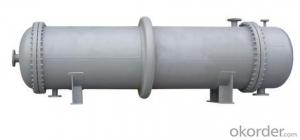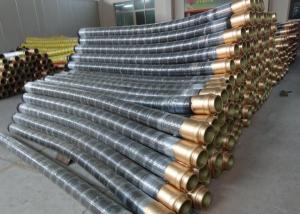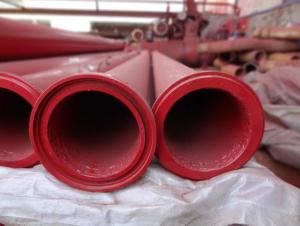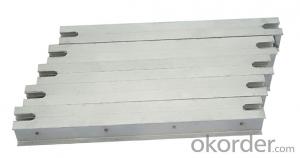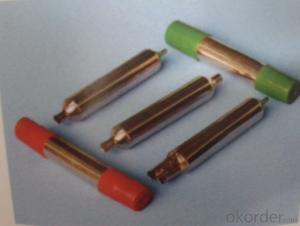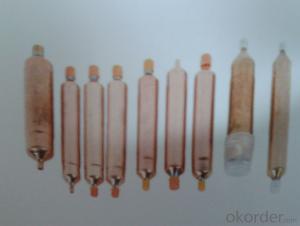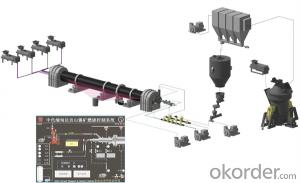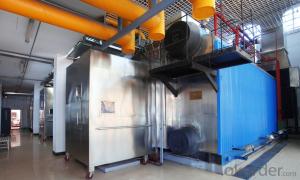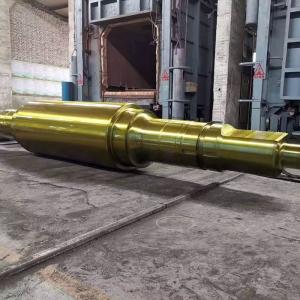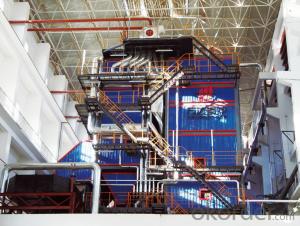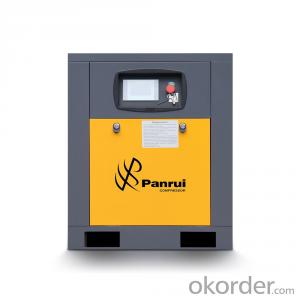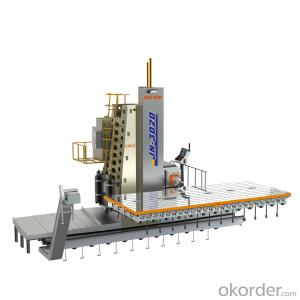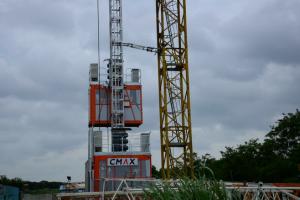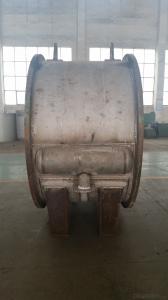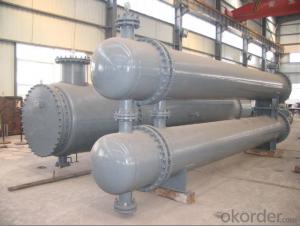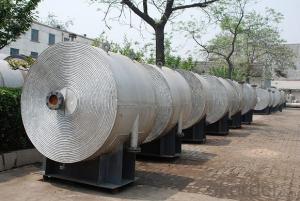condensing apparatus
- Loading Port:
- China Main Port
- Payment Terms:
- TT OR LC
- Min Order Qty:
- -
- Supply Capability:
- -
OKorder Service Pledge
OKorder Financial Service
You Might Also Like
1.Product Description:
Condenser is a high-efficient heatexchanging equipment used in alcohol, solvent, food ferment, pharmaceutical,petrochemical, refrigeration, organic chemistry, metallurgical industry,suitable for convection heat transfer of liquidtoliquid,gas to gas, gas to liquid. Condenser is made of carbon steel andstainless steel.

2.New Technology Description:
Five-ColumnThree-Effect Distillation Process


Our company designs and manufactures latestFive-ColumnThree-Effect Distillation equipment.This new process is promoted on the basisof traditional five-column differential-pressure column and mainly used forsuper-fine alcohol production.
The key of this process is the heatingmethods,the steam heats one column directly andtransfers theheat to other 4 columnsto achieve three-effect thermal couplingand energy-saving effects.
In terms of electricityefficiency, it can save 50% electricity and avoid the repairing ofcirculating pumps and also extend the working life of there-boilers.
Energy Consumption & Quality Indicator Table forSuper-fine Alcohol
No. | Item | Unit | Traditional Process | New Process |
1 | 耗汽量Steam Consumption | t/t | 3.0 | 2.3 |
2 | 色度Colority | No. | 9.5 | 8 |
3 | 乙醇 Alcohol | %(v/v) | 95.5 | 96.5 |
4 | 硫酸试验Sulfuric Acid Test | No. | 70 | 9 |
5 | 醛(以乙醛计)Aldehyde (as acetaldehyde) | mg/l | 28 | 2 |
6 | 甲醇Methanol | mg/l | 18 | 3 |
7 | 正丙醇n-propyl alcohol | mg/l | 15 | 2 |
8 | 异丁醇+异戊醇Isobutanol+isoamylol | g/l | 27.5 | 2 |
9 | 酸(以乙酸计)Acid(as acetic acid) | mg/l | 19 | 9 |
10 | 脂(乙酸乙酯)Ester (as acetic ether) | mg/l | 22 | 16 |
11 | 不挥发物Nonvolatile matter | mg/l | 23 | 12 |
12 | 重金属(以Pb计)Heavy metal | mg/l | 0.65 | 0.4 |
13 | 氰化物(以Hcn计)Cyanide(as HCN) | mg/l | 3.7 | 2 |
Double-Mash-Column Three-Effect Distillation Process


This process applies to the production ofgeneral-grade alcohol& fuel ethanol, and it was awarded Chinese nationalpatent, it is the onlysuccessfulapplicationof doublemash column & three-effect in the world,whichproduces general-grade alcohol.
This process is composed by mash column,rectification column and composite column. The composite column functions asmash column and rectification column.
The key of this process is the heatingmethods: the steam heats one column directly andtransfers the heat to other 2 columns to achieve three-effect thermal couplingand energy-saving effects.
The advantage of this process is energy-saving;itsaves over 40% steam
Energy Consumption & Quality Indicator Table for General-Grade Alcohol
No. | Item | Unit | Traditional Process | New Process |
1 | 耗电量Electricity Consumption | kwh/t | 15 | 20 |
2 | 耗汽量Steam Consumption | t/t | 2.3 | 1.4 |
3 | 耗水量Water Consumption | t/t | 7 | 5 |
4 | 色度Colority | No. | 9.5 | 8 |
5 | 乙醇 Alcohol | %(v/v) | 95.5 | 95.5 |
6 | 硫酸试验Sulfuric Acid Test | No. | 70 | 55 |
7 | 醛Aldehyde (as acetaldehyde) | mg/l | 28 | 25 |
8 | 甲醇Methanol | mg/l | 100 | 55 |
9 | 正丙醇n-propyl alcohol | mg/l | 75 | 35 |
10 | 异丁醇+异戊醇Isobutanol+isoamylol | mg/l | 27.5 | 26 |
11 | 酸(以乙酸计)Acid(as acetic acid) | mg/l | 19 | 18 |
12 | 脂(乙酸乙酯)Ester (as acetic ether) | mg/l | 22 | 20 |
13 | 不挥发物Nonvolatile matter | mg/l | 23 | 21 |
14 | 重金属(以Pb计)Heavy metal | mg/l | 0.65 | 0.5 |
15 | 氰化物(以Hcn计)Cyanide(as HCN) | mg/l | 3.7 | 3 |
3. Production Capability
1. Our company was established in the 1950s,designed and manufactured the first stainlesssteel distillation column in China.
2. Our company can produce6 full sets of equipment (including crushing section, liquefyingsaccharification section, fermentation section, distillation section and DDGSsection) in a
month.
3. Among 16 production workshops,3 workshops arefor mechanic manufacture, 5 workshops arefor manufacturing process, 8 workshopsare for assembling & welding.
4. We own advanced machining equipment and producttesting equipment.

4. Designed capability
1). We own Design License of SpecialEquipment D1 & D2 Class; Manufacture License of Special Equipment A2 Class;Design License of Special Equipment GC Class.
2).Our company achieves more than 20 patentcertificates on distillation, DDGS, and other fields.
3). Ourcompany owns ASME certification, ISO 9001 Quality System Certification, ISO14001 Environmental Management System Certification & GB/T28001Occupational Health and Safety Management System Certification

5. After-sales Service
1).Our company can provide a sophisticatedproduct after-sale service and can ensure the implementation, maintenance andcommission of projects.
2). We can reach the project site afterreceiving the user’s notification.
6.Package & Transport

- Q:I have a 14000 gallon swimming pool. Would I save money on A/C costs by using swimming pool water with a heat exchanger instead of the conventional air cooled A/C condenser?
- I have a 2,700 sq ft house and a 12,000 gallon pool. Currently, the ambient temperature (outside temp) is in the high nineties and the pool water is just under ninety degrees F. In other words, it ain't gonna work.
- Q:please give me the basic idea.
- There can be various types of heating systems : 1. Heaters directly installed across the path of the air 2. Hot water heaters exchanging the heat with the air 3. A heat pump reverse to refrigeration cycle where sink is the heated area and source is the atmosphere.
- Q:How do we reduce temperature through a cheat exchanger
- By transferring heat to a cooler substance? Could you give more detail?
- Q:Heat exchanger to use thermic oil (250-300degC) to heat soapy water from 30degC to 130degC.Type: shell and tube is most likely but plate and frame may be possible.Power is 700-750kW.Pressure is 500KPa (5bar) on both sides.Flow rate of soapy water is 65-120ltr/min (4-8cubic meters per hour). Oil flow rate depends on the unit purchased but can go up to max of 24cubic metres per hour. We are looking for one to buy ready ex stock that can match these needs as close as possible. There is no time to build or import the unit.
- ...try to call TRADEQ MDSG. tel. no. 2270533, 2276250, they are specialized on hard-to-find items, just look for joy
- Q:If so, please email me your resume. The job location is in West Chester PA.
- use the Boyle-Mariotte's law
- Q:Honeywell round therm. does heat anticipator setting effect the cooling side?
- No okorder
- Q:In a solar heating system the energy gained is during the day is stored in large tanks for use at night.Why is neither pure water or pure ethylene glycol used? O_O please help me.
- Solar thermal systems use a blend of a glycol and water to take advantage of favorable features. Glycol is included because it lowers the freezing temperature of the blend, to prevent formation of ice. Water is included because of its excellent thermal conductivity and specific heat capacity, highest among just about all fluids. The glycol is more often propylene glycol than ethylene glycol. It is surprising, but true, what the difference of two hydrogens and a carbon make in terms of toxicity...but propolyne glycol is relatively non-toxic, unlike its ethylene glycol counterpart. So, if the fluid blend is to interact with domestic use water on opposite streams of the heat exchanger, it is best to choose propolyene glycol in order not to make it a poison. If it isn't, and only will be used for heating, then ethylene glycol can be used.
- Q:Water stored in a large, well-insulated storage tank at 21.0°C and atmospheric pressure is being pumped at steady state from this tank by a pump at the rate of 40 m3/h. The motor driving the pump supplies energy at the rate of 8.5 kW. The water is used as a cooling medium and passes through a heat exchanger, where 255 kW of heat is added to the water. The heated water then flows to a second large, vented tank, which is 25 m above the first tank. Determine the final temperature of the water delivered to the second tank.q= 8.5 kW or -8.5 kWWs= 255kW or -255kwThanks!
- They are both negative in that they are adding energy to the fluid. The pump increases the pressure, that takes energy. In the heat exchanger you are also adding heat to the water so it also is negative. The temperature rise across both the pump and the heat exchanger will be positive.
- Q:Air tank, compressor, car engine, heat exchanger, and insulation for everything except car engine and heat exchanger.Air into engine, cools off, warms up by heat exchanger, compresses, back to tank Repeat. 2 tanks, switch back and forth to keep pressure constant. Fill one, Use one, then switch.Doable?
- i imagine, out of your question, that the stress and temperature of the air interior the tank do not count number number. you've defined the cylinder as being crammed at acceptable middle with 30F air at 15 PSI. artwork is then executed to move the cynlinder to the bottom position, with will cut back the stress by technique of the compression ratio. For this celebration, shall we anticipate 10::a million. The gas formulation is PV=nrT. For our applications, the stress cases the Volule divided by technique of Temperature is consistent. For this formulation, all temperatures are absolute temperatures. we are going to use the Rankine scale, which promises 459.67? to the Fahrenheit scale to grant Rankine ranges. what's the volume of the cylinder? shall we anticipate a large engine, like a 409 cubic inch displacement V8. that grants us a volume of fifty one.100 twenty 5 cubic inches for the cylinder. all of us understand the temperature, volume, and stress on the starting up. all of us understand the temperature and volume on the acceptable, and decide to understand the stress. Pi = stress preliminary Vi = volume preliminary Ti = Temperature preliminary Pf = stress very last Vf = volume very last Tf = Temperature very last Pi = 15 psi (given) Vi = 5.1125 (from compression ratio) Ti = 489.67?R Pf = unknown Vf = fifty one.100 twenty 5 (from assumption) Tf = 531.67?R (Pi * Vi)/Ti = (Pf * Vf)/Tf (15 * 5.1125) / 489.sixty seven = (Pf * fifty one.100 twenty 5) / 531.sixty seven fixing for Pf supplies Pf = a million.sixty 3 psi The temperature distinction between 30 ranges and seventy 2 ranges does no longer come on the fringe of creating up for the volume distinction between the acceptable and bottom of the stroke.
- Q:I noticed my furnace occasionally making a whoosh sound and the burner flames pop out of the burner chamber (but still inside the unit). My friend, an HVAC guy says that the heat exchanger is bad and it is sucking air into the system. He said that I need a new furnace. It still runs fine, but this sound and occasional flame are obviously worrisome. The unit is clean and there is no major debris inside. It's in a small apartment and I don't run it continuously, and it's original to the unit (24 years). Any way to avoid a major replacement by fixing?
- If it's 24 years old, you could get a much cheaper running unit, and save money. I replaced mine a couple of years ago and I've figured it will pay me back in another couple of years with fuel savings.
1. Manufacturer Overview |
|
|---|---|
| Location | |
| Year Established | |
| Annual Output Value | |
| Main Markets | |
| Company Certifications | |
2. Manufacturer Certificates |
|
|---|---|
| a) Certification Name | |
| Range | |
| Reference | |
| Validity Period | |
3. Manufacturer Capability |
|
|---|---|
| a)Trade Capacity | |
| Nearest Port | |
| Export Percentage | |
| No.of Employees in Trade Department | |
| Language Spoken: | |
| b)Factory Information | |
| Factory Size: | |
| No. of Production Lines | |
| Contract Manufacturing | |
| Product Price Range | |
Send your message to us
condensing apparatus
- Loading Port:
- China Main Port
- Payment Terms:
- TT OR LC
- Min Order Qty:
- -
- Supply Capability:
- -
OKorder Service Pledge
OKorder Financial Service
Similar products
New products
Hot products
